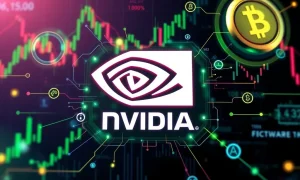Nvidia stands at the forefront of artificial intelligence innovation. However, a complex geopolitical strategy, initially aimed at slowing China’s AI development, has created an unexpected challenge for the tech giant. This policy shift, intended to limit Beijing’s technological progress, has instead reshaped the global AI chip market, directly impacting Nvidia’s business operations and long-term strategy.
Many observers initially viewed these measures as a direct hit on China’s technological ambitions. Yet, the intricate web of global supply chains and market dynamics means that such actions rarely have isolated effects. Consequently, companies like Nvidia, deeply embedded in the international tech ecosystem, faced significant repercussions. This article delves into how these policies unfolded and their profound, often unintended, consequences for Nvidia and the broader AI industry.
Understanding the US Strategy and Nvidia’s Position
The United States government initiated a series of stringent export controls. These measures aimed to curb China’s access to advanced semiconductor technology. Washington’s primary goal was to prevent Beijing from leveraging cutting-edge AI for military modernization and surveillance. Therefore, specific restrictions targeted high-performance computing chips, crucial for AI development.
Meanwhile, Nvidia had established itself as the undisputed leader in AI chip manufacturing. Its Graphics Processing Units (GPUs) power most of the world’s AI data centers and research labs. Furthermore, China represented a substantial market for Nvidia. The company generated a significant portion of its revenue from sales to Chinese tech giants and research institutions. Indeed, its dominance in this niche made it a critical player in the global AI race.
The US government’s strategy specifically targeted chips with high processing power. This directly impacted Nvidia’s most advanced products, such as the A100 and H100 GPUs. These chips are essential for training large language models and other complex AI applications. Therefore, limiting their export to China became a cornerstone of the US policy.
This situation created a difficult balancing act for Nvidia. The company needed to comply with US regulations while also maintaining its market presence in China. Consequently, the firm explored various avenues to navigate these new restrictions. This included developing alternative products tailored to meet the export control thresholds. Ultimately, the goal was to serve its Chinese customers without violating US law.
The Direct Impact on Nvidia’s China Operations
The implementation of export controls immediately affected Nvidia’s sales in China. US regulations prohibited the direct sale of its most powerful AI chips. This forced Nvidia to adjust its product offerings for the Chinese market. For instance, the company introduced specific versions of its GPUs, like the A800 and H800. These chips featured reduced performance metrics, ensuring compliance with export limits.
However, these compliant chips often carried lower profit margins. They also faced competition from other chipmakers. Consequently, Nvidia’s revenue projections from China saw a significant hit. The demand for high-end AI chips remained robust in China. Yet, Nvidia could not fully capitalize on it due to the restrictions. This situation underscored the complex challenges of navigating geopolitical tensions in a globalized market.
Furthermore, the uncertainty surrounding future regulations created a challenging environment. Businesses prefer stable and predictable trade policies. However, the evolving nature of US-China tech relations introduced considerable risk. This uncertainty influenced Nvidia’s investment decisions and long-term planning for the region. Many Chinese customers also began seeking alternative suppliers to mitigate their own risks.
The impact extended beyond just sales figures. It also affected Nvidia’s strategic partnerships and research collaborations within China. Building trust and long-term relationships becomes difficult when regulatory frameworks are constantly shifting. Therefore, Nvidia had to re-evaluate its entire approach to the Chinese market. This included a greater focus on software and services, which were less affected by hardware export controls.
China’s Domestic AI Chip Ambitions and Nvidia
The US sanctions inadvertently accelerated China’s drive for technological self-sufficiency. Beijing had already prioritized domestic semiconductor development. However, the export controls provided a strong impetus for this initiative. Chinese tech companies, no longer guaranteed access to cutting-edge foreign chips, invested heavily in local alternatives. This move created new domestic competitors for Nvidia.
Chinese firms like Huawei’s Ascend unit and Alibaba’s T-Head division began ramping up their AI chip production. These companies benefited from substantial government support and investment. While their current technology may not match Nvidia’s most advanced offerings, their progress has been rapid. They are quickly closing the gap in certain segments of the AI chip market. This presents a significant long-term threat to Nvidia’s dominance.
Moreover, Chinese customers started prioritizing domestic suppliers. This shift was not solely due to performance considerations. It also reflected a strategic move to reduce reliance on foreign technology. They aimed to enhance national security and economic resilience. Consequently, Nvidia faced not only export restrictions but also a growing preference for local solutions.
This domestic push by China means that even if sanctions ease, Nvidia may find a different market landscape. Chinese companies will likely continue to foster their homegrown chip capabilities. This could lead to a permanent reduction in Nvidia’s market share in China. Therefore, the policies designed to slow China’s AI development may have instead cultivated a stronger domestic competitor for Nvidia.
Reshaping the Global AI Chip Market: Beyond Nvidia
The US-China tech tensions have far-reaching implications beyond just Nvidia. They are fundamentally reshaping the global AI chip market. Companies worldwide are now reassessing their supply chain vulnerabilities. They seek to diversify their manufacturing and sourcing to mitigate geopolitical risks. This shift could lead to a more fragmented, yet potentially more resilient, global semiconductor industry.
Other countries are also accelerating their own chip manufacturing initiatives. Nations in Europe, as well as Japan and India, are investing heavily in domestic semiconductor production. They aim to reduce their dependence on a few key regions or companies. This global push for chip independence could create new opportunities for diverse players. However, it also means increased competition for established leaders like Nvidia.
Furthermore, the focus on ‘decoupling’ has spurred innovation in alternative architectures. While Nvidia’s CUDA ecosystem remains dominant for GPUs, companies are exploring other computing paradigms. This includes specialized AI accelerators and neuromorphic chips. These alternative approaches could offer new pathways for AI development, potentially bypassing traditional GPU dominance.
Ultimately, the global AI chip market is becoming more complex and multifaceted. The era of a single dominant supplier, or a highly centralized supply chain, may be drawing to a close. This new landscape requires all players, including Nvidia, to adapt their strategies. They must navigate a world where geopolitical considerations are as important as technological prowess.
Navigating the Future: Nvidia’s Strategic Adjustments
Nvidia has responded to these challenges with strategic adjustments. The company continues to innovate rapidly, pushing the boundaries of AI chip performance. It also diversifies its revenue streams. For instance, Nvidia is expanding its focus on software platforms and enterprise solutions. These areas are less susceptible to hardware export controls. Its AI Enterprise software suite, for example, offers significant growth potential.
Moreover, Nvidia is strengthening its presence in other global markets. It seeks to reduce its proportional reliance on China. The company is investing in research and development facilities across different regions. It also forms partnerships with businesses in various countries. This global expansion strategy aims to create a more balanced and resilient business model for Nvidia.
The company also engages in continuous dialogue with governments. It aims to ensure that future policies are pragmatic and do not unduly harm innovation. Nvidia understands the importance of national security concerns. However, it also advocates for a balanced approach that supports global technological progress. This proactive engagement is crucial for navigating the evolving regulatory landscape.
In addition, Nvidia is exploring new applications for its technology. It is moving beyond traditional data centers into areas like robotics, autonomous vehicles, and the metaverse. These emerging markets represent significant growth opportunities. They also offer pathways to diversify revenue beyond core AI training chips. Therefore, Nvidia’s long-term strategy involves broad technological leadership and market diversification.
The Trump administration’s efforts to slow China’s AI development created a ripple effect. This effect reached far beyond its initial intentions. While aiming to limit Beijing’s technological advancement, these policies inadvertently prompted China to accelerate its domestic chip capabilities. Consequently, Nvidia, a global leader in AI chips, faced significant challenges and strategic shifts. The company had to adapt its product offerings and market approach in China. It also intensified its global diversification efforts. This complex interplay highlights the intricate nature of global technology, trade, and geopolitics. Ultimately, the outcome is a more competitive and decentralized global AI chip market, a landscape where Nvidia continues to innovate and adapt.
Frequently Asked Questions (FAQs)
What was the main goal of the US policies regarding China’s AI development?
The primary goal was to prevent China from accessing advanced semiconductor technology. This aimed to slow down Beijing’s progress in artificial intelligence, particularly for military and surveillance applications.
How did these policies specifically impact Nvidia?
The policies restricted Nvidia’s ability to sell its most powerful AI chips, like the A100 and H100, directly to China. This forced Nvidia to create downgraded versions (e.g., A800, H800) for the Chinese market, which often came with lower profit margins and faced increased competition.
Did China’s AI development slow down as a result of these policies?
While the policies created immediate challenges for China’s access to high-end chips, they also accelerated China’s domestic chip development efforts. This push for self-sufficiency led to significant investment in local chip manufacturers, potentially strengthening China’s long-term AI capabilities.
What strategic adjustments has Nvidia made in response to these challenges?
Nvidia has diversified its product offerings, creating compliant chips for China. It has also expanded its focus on software and enterprise solutions, which are less affected by hardware restrictions. Furthermore, Nvidia is strengthening its presence in other global markets to reduce reliance on China.
How has the global AI chip market changed due to these geopolitical tensions?
The global AI chip market has become more fragmented and competitive. Many countries are now investing in domestic chip manufacturing to reduce supply chain vulnerabilities. This has led to a push for alternative chip architectures and increased competition for established players like Nvidia.
What is the long-term outlook for Nvidia in the Chinese market?
The long-term outlook for Nvidia in China remains complex. While the company continues to serve the market with compliant products, the rise of domestic Chinese competitors and ongoing geopolitical uncertainty suggest a more challenging environment. Nvidia will likely continue to adapt its strategy, balancing compliance with market opportunity.








